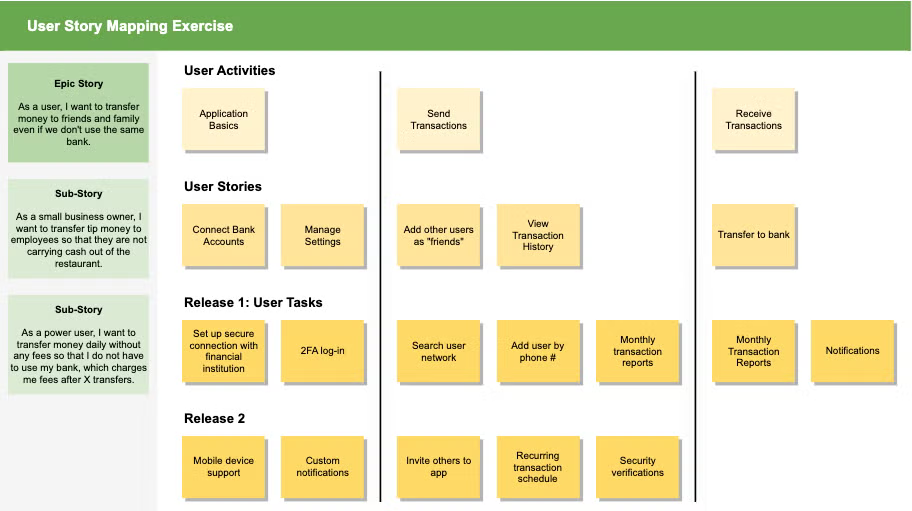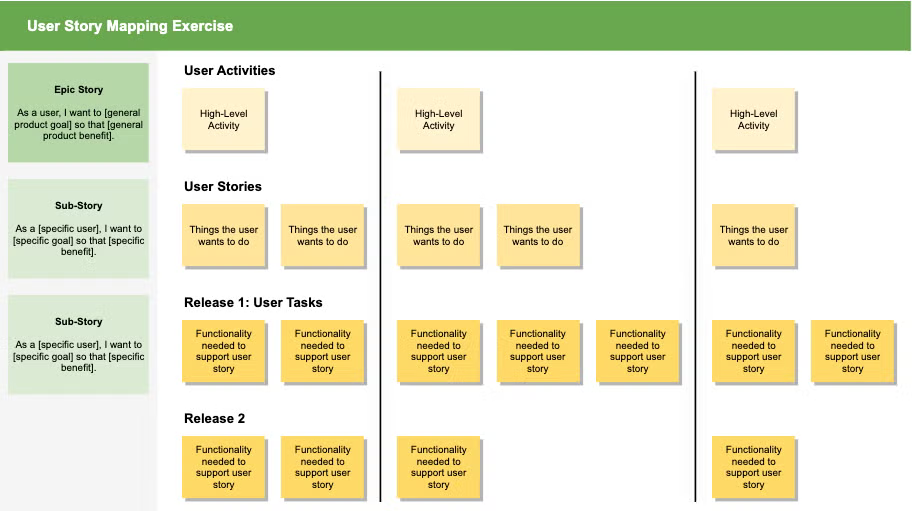Let’s say you have a brilliant product or application idea. It’s gold. A new market opportunity. None of your competitors are playing in this space.
If you’re like most companies or startups, this product or app is still likely to fail. Numbers vary based on who you ask, but seasoned entrepreneurs will grimly warn you that roughly 90% of startups and more than 99% of consumer applications fail.
Why? Poor user research.
One of the common downfalls for startups or new ideas is user research that fails to account for how user behavior will impact adoption of your app or service. Story mapping covers this gap — it’s how you avoid creating a product, app, or website that doesn’t account for what your users will need to meet their goals.
➡️ If you're already familiar with the exercise, start a free trial of Gliffy's easy-to-use story mapping tool today >>
What is Story Mapping?
Back to topUser story mapping is an approach to product discovery that uses visual systems and user experience research to align product functionality, user experience needs, and development tasks. The story map organizes user stories into functionality groupings, allowing the technical team to develop a more user-centric app or product.
How to Get Started With User Story Mapping
Story mapping is a strategic approach for translating user stories into actionable product or application development steps. You can get started with a simple whiteboard and sticky-notes approach, but using an online diagramming tool like Gliffy will make it easier to preserve, document, and share your work. Story mapping can be broken down into some basic components, including:
- Vision: The overarching product or application vision, decided by product owners, founders, and C-Suite members.
- Goals: A documented set of concrete objectives, defined by a collaborative team of executives, project managers, and technical professionals.
- Activities: Goals translated into broad activity for entire team, such as a functionality grouping.
- Tasks and User Stories: Specific subcomponents of activities, expressed in first-person user story statements.
Story mapping is a great brainstorming technique for product teams who are developing new features or new products, sometimes in tandem with other UX-focused exercises like customer journey mapping or empathy mapping. It can also be a helpful framework while developing a new business plan, along with exercises like the business model canvas.
User Story Examples
There’s a specific formula teams use to create user stories. It looks roughly like the following statement:
As a [insert specific type of user] I want [insert specific goal] so that [insert specific reason or desired outcome].
Every user story will look a bit different based on what you’re building and your goals. But overall they should be written from the end user perspective. They should also provide clarity and stimulate discussion among your agile development team.
Once teams have clarified the statements they need to focus on, they can start brainstorming specific features and functionality that will support their users. If you’re using a tool like Gliffy, it’s easy to drag and drop shapes to capture each idea for features or functionality in your discussion. On a humble whiteboard, sticky notes can help you organize and reorganize your ideas.

To put this exercise in the context of development frameworks often used by agile teams, user stories can be broken down into categories based on the functionality goals and activities being addressed. Often, your map will start at an “epic” level that describes high-level user activities. Teams will then drill down into sub-stories and tasks to discuss the purpose of features and the functionality they need to build.
Let’s use the above example of a consumer-oriented payments processing application. The levels of user stories could look like the following:
Epic Story Example
As a user, I want to transfer money to friends and family even if we do not use the same bank.
Sub-Story or User Task Examples
As a small business user, I want to transfer tip money to employees so that they are not carrying cash out of the restaurant.
As a power user, I want to transfer money daily without any fees so that I do not have to rely on my bank, which charges me monthly fees.
As you can see in the above examples, the motivations, needs, and desires of app users can vary substantially. Additionally, by creating more detailed user stories, the team can begin to hone in on specific functionality or different user journeys that will be required in order to succeed with the app.
Back to topStory Mapping Templates
Because story mapping is such a diverse exercise, there’s no single agreed upon template. Nonetheless, there are some basic templates you can try with your team. Remember, every team has different needs and cultures. It’s okay if you start with a template and make it your own. In fact, your project will only be more successful that way.
 Back to top
Back to top
Get Started with Gliffy's User Story Mapping Tool
Gliffy offers tons of templates and simple, drag-and-drop diagramming functionality for getting your story mapping exercise off to a good start. In addition to using Gliffy as a story mapping tool, you can also try dragging and dropping your way through other brainstorming techniques, customer journey mapping and impact mapping exercises, and more.
Get started with a free trial of our Confluence App, Gliffy Diagrams for Confluence. You can get an agile story mapping team up and running with Gliffy free of charge to give it a try!